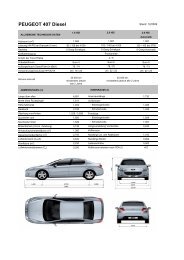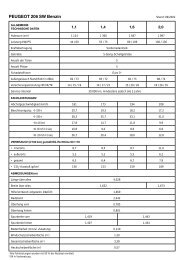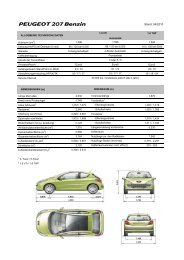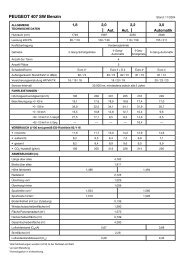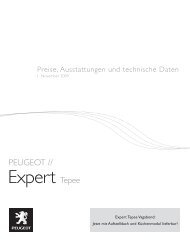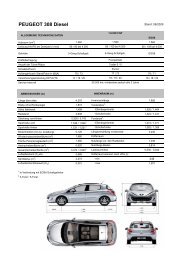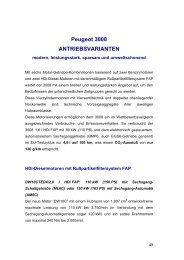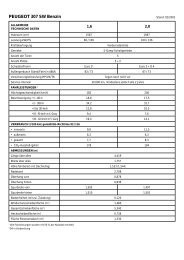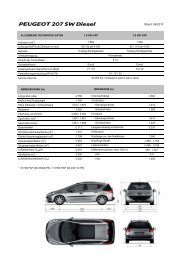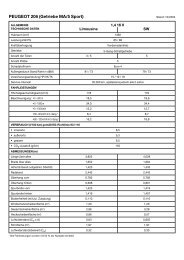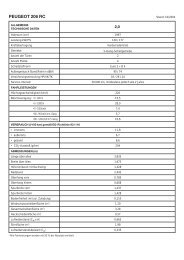PSA COUV page . page RA GB - PEUGEOT Presse
PSA COUV page . page RA GB - PEUGEOT Presse
PSA COUV page . page RA GB - PEUGEOT Presse
You also want an ePaper? Increase the reach of your titles
YUMPU automatically turns print PDFs into web optimized ePapers that Google loves.
Group financing<br />
the recognition in the income statement<br />
of €95 million worth of actuarial<br />
differences related to benefit obligations<br />
towards employees less than 59 years of<br />
age under the French defined benefit plan,<br />
as well as by the €35 million amortization<br />
of deferred items at year-end 2001.<br />
External funds used to finance benefit<br />
payments contracted to €1,668 million as<br />
of December 31, 2002 from €2,108 million<br />
at end-2001. The decline was primarily<br />
attributable to the withdrawal of €228<br />
million from these funds to finance part of<br />
the €384 million lump sum payment made<br />
to an insurance company in exchange for<br />
the transfer to this company of the Group’s<br />
entire obligation towards employees less<br />
than 59 years of age under the defined<br />
benefit plan. It also reflected a €160 million<br />
fall in the value of the external funds.<br />
Reserves carried on the balance sheet in<br />
respect of the portion of benefit obligations<br />
not covered by external funds amounted<br />
to €247 million as of December 31, 2002<br />
and €244 million at end-2001.<br />
The Group has no obligation to pay<br />
additional contributions to external funds,<br />
other than in the United Kingdom, apart<br />
from the obligation to pay benefits when<br />
they fall due. In the United Kingdom,<br />
based on the present value of external<br />
funds, the Group may be required by local<br />
regulations to pay a maximum of €70<br />
million in additional contributions in each<br />
of the next three years.<br />
The charge recorded in accordance with<br />
the standards described above amounted<br />
to €130 million, excluding the effect of the<br />
exceptional amortization of deferred items<br />
related to employees in France under 59<br />
years of age. Charges for 2001 and 2000<br />
stood at €90 million and €85 million<br />
respectively. The estimated charge for<br />
2003 is €164 million.<br />
Return on capital employed<br />
1. DEFINITION AND METHODS<br />
Return on capital employed (ROCE) has<br />
been selected as the standard indicator of<br />
the Group’s overall financial performance.<br />
Capital employed includes the value of all<br />
operating assets and liabilities used by the<br />
Group in its business operations. Return<br />
on capital employed is measured on the<br />
basis of income generated by capital<br />
employed, which corresponds mainly to<br />
operating margin plus or minus the other<br />
income and expense items included in the<br />
ROCE calculation.<br />
Pre-tax ROCE corresponds to the ratio of<br />
income generated by capital employed to<br />
total capital employed at December 31 of<br />
each year. The definition and the<br />
calculation of capital employed, income<br />
generated by capital employed and return<br />
on capital employed are presented in note<br />
44 to the consolidated financial statements.<br />
After-tax ROCE is calculated on the basis<br />
of a standard income tax rate of 33 1/3%,<br />
corresponding to the average tax rate<br />
applied to the Group’s recurring results<br />
of operations.<br />
2. CAPITAL EMPLOYED<br />
Capital employed stood at €15,407<br />
million as of December 31, 2002, slightly<br />
down on the end-2001 figure. The<br />
accounting for DCAC had an impact of<br />
€259 million. Based on a comparable<br />
scope of consolidation, capital employed<br />
contracted by 3.2%, reflecting the<br />
Group’s success in containing capital<br />
expenditure, which is increasingly covered<br />
by depreciation of operating assets. The<br />
decrease also reflects tight control over<br />
inventories, which were virtually<br />
unchanged at December 31, 2002<br />
compared with the previous year-end, and<br />
even slightly lower in the case of new<br />
vehicle inventories. Lastly, capital<br />
employed was favorably impacted by the<br />
increase in supplier credit to a more<br />
normal level. This item dropped sharply<br />
at the end of 2001, due to the scaling<br />
down of production in the fourth quarter<br />
(see Group Financing, 3.1 above).<br />
Capital employed amounted to €15,654<br />
million as of December 31, 2001, up<br />
€2,666 million on the end-2000 figure.<br />
The increase stemmed from Faurecia’s<br />
acquisition of Sommer Allibert’s automobile<br />
business, which had capital employed of<br />
€1,986 million at the date of acquisition.<br />
Based on a comparable scope of<br />
consolidation, capital employed rose by<br />
114<br />
<strong>PSA</strong> <strong>PEUGEOT</strong> CITROËN - MANAGING BOARD REPORT




